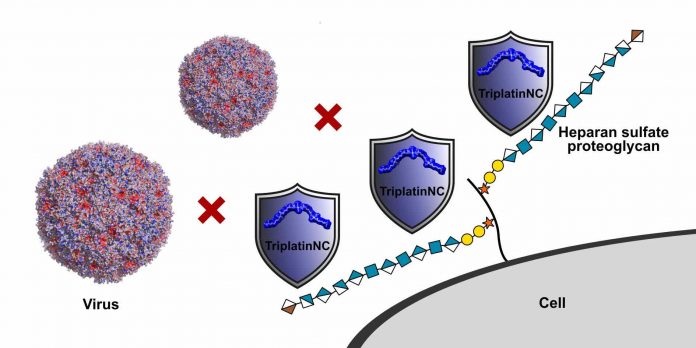A class of metal-based anti-viral compounds can shield human cells from viruses and may also trap them to prevent viral spread, new Griffith University research has found.
Published in the Royal Society of Chemistry (RSC) journal, ChemComm, the Institute for Glycomics researchers identified that the metal-based compounds protect cells from viruses causing hand, foot and mouth disease (enterovirus 71) and metapneumovirus respiratory infection (human metapneumovirus, hMPV).
Using a variety of methods including NMR spectroscopy, virology and computational modelling, they discovered that the platinum-based complex (PPC) TriplatinNC binds in a specific manner to the large sugar biomolecule Heparan Sulfate (HS), found on the surface of cells and acts as a shield from viruses.
“This is a very exciting discovery,” said lead researcher Dr Benjamin Bailly. “For the first time we provide a detailed description of how these compounds work to block infection. Not only do they act as a protective shield at the host cell surface, we found that they may also trap viruses to prevent them from further propagating in the host.
“We knew that PPCs interact with the HS receptor and that these viruses recognise HS, so we wanted to investigate if they would protect the host cells from being infected.”
Dr Bailly said many viruses utilise HS as a binding receptor for cellular entry including EV71 which causes hand, foot and mouth disease in children and hMPV which causes pneumonia in infants and the elderly.
“These are very different diseases, but the common link is the way the PPCs and viruses recognise the HS receptor on host cell surfaces.
Director of the Institute and senior author, Professor Mark von Itzstein AO said the study “is an exciting proof-of-concept that our metalloglycomics approach provides new direction in antiviral drug discovery”.
“The shielding effect of TriplatinNC on EV71 and hMPV shows the potential of metal-based compounds as broad-spectrum anti-virals which are expected to be active on other HS-binding viruses.
“We now have a new framework in hand to develop compounds with improved safety and strong antiviral properties, so they can be used against a broad spectrum of viral diseases” he said.








